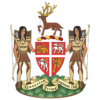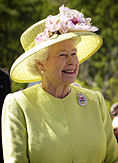- Monarchy in Newfoundland and Labrador
-
Queen in Right of Newfoundland and Labrador Monarchy Provincial/State 
Coat of arms of Newfoundland and Labrador
Incumbent:
Elizabeth II
Queen of Canada
since 6 February 1952Style: Her Majesty First monarch: George VI Formation: 31 March 1949 Residence: Government House, St. John's By the arrangements of the Canadian federation, the Canadian monarchy operates in Newfoundland and Labrador as the core of the province's Westminster-style parliamentary democracy.[1] As such, the Crown within Newfoundland and Labrador's jurisdiction is referred to as the Crown in Right of Newfoundland and Labrador,[2] Her Majesty in Right of Newfoundland and Labrador,[3] or the Queen in Right of Newfoundland and Labrador.[4] The Constitution Act, 1867, however, leaves many royal duties in Newfoundland and Labrador specifically assigned to the sovereign's viceroy, the Lieutenant Governor of Newfoundland and Labrador,[1] whose direct participation in governance is limited by the conventional stipulations of constitutional monarchy.[5]
Contents
Constitutional monarchy in Newfoundland and Labrador
Main article: Monarchy in the Canadian provincesThe role of the Crown is both legal and practical; it functions in Newfoundland and Labrador in the same way it does in all of Canada's other provinces, being the centre of a constitutional construct in which the institutions of government acting under the sovereign's authority share the power of the whole.[6] It is thus the foundation of the executive, legislative, and judicial branches of the province's government.[7] The Canadian monarch — since 6 February 1952, Queen Elizabeth II — is represented and her duties carried out by the Lieutenant Governor of Newfoundland and Labrador, who's direct participation in governance is limited by the conventional stipulations of constitutional monarchy, with most related powers entrusted for exercise by the elected parliamentarians, the ministers of the Crown generally drawn from amongst them, and the judges and justices of the peace.[5] The Crown today primarily functions as a guarantor of continuous and stable governance and a nonpartisan safeguard against the abuse of power.[5][8][9] This arrangement began with the granting in 1949 of Royal Assent to the Newfoundland Act and continued an unbroken line of monarchical government extending back to the late 15th century.[10] However, though Newfoundland and Labrador has a separate government headed by the Queen, as a province, Newfoundland and Labrador is not itself a kingdom.[11]
Government House in St. John's is owned by the sovereign in her capacity as Queen in Right of Newfoundland and Labrador, and is used as an official residence oth by the lieutenant governor and the sovereign and other members of the Canadian Royal Family will reside there when in Newfoundland and Labrador.
Royal associations
Further information: Royal tours of CanadaThose in the Royal Family perform ceremonial duties when on a tour of the province; the royal persons do not receive any personal income for their service, only the costs associated with the exercise of these obligations are funded by both the Canadian and Newfoundland and Labrador Crowns in their respective councils.[12] Monuments around Newfoundland and Labrador mark some of those visits, while others honour a royal personage or event. Further, Newfoundland and Labrador's monarchical status is illustrated by royal names applied regions, communities, schools, and buildings, many of which may also have a specific history with a member or members of the Royal Family. Associations also exist between the Crown and many private organizations within the province; these may have been founded by a Royal Charter, received a royal prefix, and/or been honoured with the patronage of a member of the Royal Family. Examples include the Royal Newfoundland Constabulary, which received its royal prefix from Queen Elizabeth II in 1979, and the Royal St. John's Regatta, which has the Queen as its patron and received its royal prefix from her in 1993.
Queen Elizabeth is the best known and the most widely travelled Head of State in the world. Her several visits to Canada have taken her from sea to sea to sea, and the people of Newfoundland and Labrador have welcomed her a number of times.[13]
Edward Roberts, Lieutenant Governor of Newfoundland and Labrador, 2002The main symbol of the monarchy is the sovereign herself, her image (in portrait or effigy) thus being used to signify government authority.[14] A royal cypher or crown may also illustrate the monarchy as the locus of authority, without referring to any specific monarch. Further, though the monarch does not form a part of the constitutions of Newfoundland and Labrador's honours, they do stem from the Crown as the fount of honour, and so bear on the insignia symbols of the sovereign.
History
Main article: History of monarchy in CanadaBy commission under the Royal Prerogative of Queen Elizabeth I, Sir Humphrey Gilbert claimed the island of Newfoundland on 5 August 1583. By the mid 1660s, however, the French Crown had also laid claim to nearly half of the same area. Disputes over the island were ended as the French kings ceded Terre Neuve to the British Crown via the Treaty of Utrecht in 1713 and later the Treaty of Paris in 1763, in-between which, in 1729, the Royal Newfoundland Constabulary was established.
The colony's status was in 1825 elevated to that of a province of the Crown and, in 1907, it was made by King Edward VII, on the advice of his Imperial Privy Council in London, into a Dominion of the British Empire. Following two referendums in 1948, the island joined Canadian Confederation the next year, making it the only province to do so by authority of the Canadian monarch.
Princess Mary, Princess Royal, in 1964 marked the 50th anniversary of the departure of the first contingent of the Royal Newfoundland Regiment from St. John's to the battlefields of World War I. Prince Charles, Prince of Wales, along with his wife Diana, Princess of Wales, also visited Newfoundland in 1983, to mark the 400th anniversary of the island becoming a British colony.[15] And, during her 1997 tour of Canada, Queen Elizabeth II, along with her husband, Prince Philip, Duke of Edinburgh, travelled to Bonavista to see the arrival of the Matthew, as part of the re-enactment of John Cabot's arrival on the island 500 years before.
See also
References
- ^ a b Victoria (29 March 1867), Constitution Act, 1867, III.9, V.58, Westminster: Queen's Printer, http://www.solon.org/Constitutions/Canada/English/ca_1867.html, retrieved 15 January 2009
- ^ Elizabeth II (4 June 2004), Loan Guarantee Act, 1957, 4.1, Saint John's: Queen's Printer for Newfoundland and Labrador, http://www.canlii.org/nl/laws/sta/1957c.70/20040609/whole.html, retrieved 12 July 2009
- ^ Elizabeth II (28 February 2009), Copper-in-Concentrate Exemption Order, 2009, 2.b, Saint John's: Queen's Printer for Newfoundland and Labrador, http://www.assembly.nl.ca/legislation/sr/annualregs/2009/nr090010.htm, retrieved 12 July 2009
- ^ Elizabeth II, Land Claims Agreement Between the Inuit of Labrador and Her Majesty the Queen in Right of Newfoundland and Labrador and Her Majesty the Queen in Right of Canada, Ottawa: Queen's Printer for Canada, p. 1, http://www.ainc-inac.gc.ca/al/ldc/ccl/fagr/labi/labi-eng.pdf, retrieved 12 July 2009
- ^ a b c MacLeod, Kevin S. (2008), A Crown of Maples (1 ed.), Ottawa: Queen's Printer for Canada, p. 16, ISBN 978-0-662-46012-1, http://www.pch.gc.ca/pgm/ceem-cced/fr-rf/crnCdn/crn_mpls-eng.pdf
- ^ Cox, Noel (September 2002). "Black v Chrétien: Suing a Minister of the Crown for Abuse of Power, Misfeasance in Public Office and Negligence". Murdoch University Electronic Journal of Law (Perth: Murdoch University) 9 (3): 12. http://www.murdoch.edu.au/elaw/issues/v9n3/cox93.html. Retrieved 17 May 2009.
- ^ Privy Council Office (2008), Accountable Government: A Guide for Ministers and Ministers of State – 2008, Ottawa: Queen's Printer for Canada, p. 49, ISBN 978-1-100-11096-7, http://www.pco-bcp.gc.ca/index.asp?lang=eng&page=information&sub=publications&doc=ag-gr/2008/ag-gr-eng.htm, retrieved 17 May 2009
- ^ Roberts, Edward (2009). "Ensuring Constitutional Wisdom During Unconventional Times". Canadian Parliamentary Review (Ottawa: Commonwealth Parliamentary Association) 23 (1): 15. http://www2.parl.gc.ca/Sites/LOP/Infoparl/32/1/32n1_09e_Roberts.pdf. Retrieved 21 May 2009.
- ^ MacLeod 2008, p. 20
- ^ George VI (23 March 1949), Newfoundland Act, 8.1, Ottawa: King's Printer for Canada, http://www.solon.org/Constitutions/Canada/English/nfa.html, retrieved 16 June 2009
- ^ Forsey, Eugene (31 December 1974), "Crown and Cabinet", in Forsey, Eugene, Freedom and Order: Collected Essays, Toronto: McClelland & Stewart Ltd., ISBN 978-0771097737
- ^ Palmer, Sean; Aimers, John (2002), The Cost of Canada's Constitutional Monarchy: $1.10 per Canadian (2 ed.), Toronto: Monarchist League of Canada, archived from the original on 19 June 2008, http://web.archive.org/web/20080619203100/http://www.monarchist.ca/new/docs/costofcrown.html, retrieved 15 May 2009
- ^ Roberts, Edward (6 February 2002), "Remarks by His Honour, Ceremony to mark the Queen's Golden Jubilee & to launch a book and video on Government House", in Office of the Lieutenant Governor of Newfoundland and Labrador, News > News Archives > 2002, St. John's: Queen's Printer for Newfoundland and Labrador, http://www.mun.ca/govhouse/news-feb6_02.html, retrieved 14 April 2007
- ^ MacKinnon, Frank (1976), The Crown in Canada, Calgary: Glenbow-Alberta Institute, p. 69, ISBN 978-0-7712-1016-7
- ^ "On This Day > June 24, 1983 > Charles and Diana charm Newfoundlanders". CBC. 23 June 1983. http://archives.cbc.ca/on_this_day/06/24/. Retrieved 12 July 2009.
 Canadian monarchy
Canadian monarchyThe Crown Viceroys Constitutional Queen-in-Council · Queen-in-Parliament · Queen-on-the-Bench · Queen's peace · The Canadian Crown and the Canadian Forces · The Canadian Crown and Aboriginal peoplesLegal Ceremonial and symbolic Related  Politics of Newfoundland and Labrador
Politics of Newfoundland and LabradorThe Crown Sovereign • Queen Elizabeth IILieutenant Governor Premier Kathy Dunderdale • Former premiersOpposition Leader Speaker of the Assembly Ross Wiseman • Former Speakers of the AssemblyLegislative Assembly Former Assemblies • Executive Council (Cabinet)Political parties Elections Other Canadian politics Politics of the provinces and territories of Canada This article is part of the series: Politics and government of CanadaSovereign in the provinces Lieutenant Governors Commissioners Premiers Legislatures Elections OtherCategories:- Monarchy in Canada
- Politics of Newfoundland and Labrador
- Newfoundland national leaders
Wikimedia Foundation. 2010.


